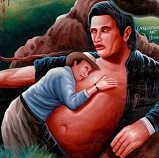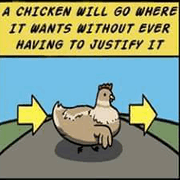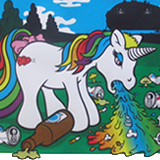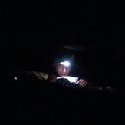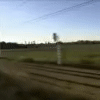George Zimmer posted:Class I employee here: I expect another big merger in the next fifteen years and a bunch of new short lines in the next five. 1 merger means 2 mergers. its just a matter of how they pair up. a canadian road with an east coast road or a transcon merger. i dont think that the stb/congress/canadian regulators will allow it because there is very little benefit to anyone that isn't a shareholder. naturally, the big 6 north american railroads want to merge. there's less competition. rates go up, wages stagnate. they can eliminate some duplicate headquarters job functions(1 ceo vs 2 ceo and on down the line) there are some dubious benefits to for the shipper, eliminating the chicago interchange and rates(via cost reduction) are usually mentioned. i don't think that rates have ever dropped and stayed low in the aftermath of a merger. i think that the chicago interchange is a red herring. you can interchange all that traffic at other points but it costs one road or the other some linehaul and that wont fly. the big 6 effectively operate without any real competition. the other class 1 in the region can steal some business here and there but most facilities only have access to 1 railroad anyways. in places where you might be able to dual served at one end, the other end probably isn't. likewise, there is very little real competition in intermodal domestic lanes. csx owns the new england market because it's a full day faster to worcester(which is also closer to boston than the ns ramp). ns owns the atlanta-ny/nj lane because its double stacked the whole way through. international is a little less sensitive to time so they can be a little pickier. shortlines don't offer real competition to a class 1 and saying that there will be new shortlines in the next 5 isn't surprising. csx is selling off whatever they can to pump the p&l statement(less cost, the linesale counts as profit). ns and up will do the same. if they're smart about it, they structure the deal and the property so that they can get their cake and eat it to. you dont sell lines with a connection to other railroads. you're the only company that can give them cars for local delivery. the class 1 gets all the linehaul and dump the local service operation on the shortline. you do the same, in reverse, for the traffic they're giving you. that's the most desirable state for a railroad to be in. you dont make very much money delivering cars to warehouses or chemical plants. you make a shitpot of money moving the cars between yards.
|
|
|
|
|

|
| # ? May 9, 2024 19:49 |
|
The DoD shot down any Canadian/US rail merger when Harrison tried buying out CSX while at CP, so that specific idea is going nowhere.
|
|
|
iospace posted:The DoD shot down any Canadian/US rail merger when Harrison tried buying out CSX while at CP, so that specific idea is going nowhere. no, they didn't. they opposed placing cp in a voting trust with harrison as ceo as an interim measure while the stb ruled on the subject. im not legal expert, but i dont think that the dod has a direct say in the matter. maybe a de facto ability to block something, but not a de jure ability. https://www.railwayage.com/regulatory/doj-dod-oppose-cp-ns-combination/ in fact, the canadians have bought or merged a number of us railroads and did so in an era where rail transportation was a much more prominent. soo lines, ic, grand trunk, delaware and hudson, etc. further, merger talks of a canadian and american road continue right now. vains fucked around with this message at 02:42 on Feb 7, 2019 |
|
|
|
|
I thought they were staunchly opposed to a foriegn company handling their contracts, or that's how I read it.
|
|
|
|
https://i.imgur.com/n0Wonit.mp4
|
|
|
|

|
|
|
|
https://en.wikipedia.org/wiki/2003_Melbourne_runaway_train Suburban electric passenger train runs away, they cut the overhead power but it doesn't stop it going downhill towards the city. Investigation report: https://www.atsb.gov.au/media/24454/rair2003001_001.pdf quote:
|
|
|
|
Reading the timeline of events, that was handled monumentally poorly. I hope most railroads have better emergency management training in place than that (haha yeah right).
|
|
|
|
It's very much not a train thing, but that still reminded me of the Helge Ingstad frigate incident we had back before Christmas, where a navy ship very calmly navigated straight into an equally calm oil tanker - the communication from everyone involved was completely atrocious, and if anyone at any point had said something like "you are aiming straight at an oil tanker 700m in front of you" instead of vague questions (and the memorable "so we'll have a collision here, then") we could probably have kept a hundreds-of-millions-of-dollars warship above water. The incident investigation hasn't finished yet, but there's a reasonable summary of what's publicly known here. (Except that I don't think "ashore" means what he thinks it does.) Computer viking fucked around with this message at 12:14 on Mar 4, 2019 |
|
|
|
It gets worse. The govt solicited bids to keep the ship from sinking. But the team that raised the Costa Concordia wanted a lot of money, so another group was hired. The cheaper plan of "chain it to rocks and pump the water out" failed, the ship sank, it's a total loss.
|
|
|
|
|
Just needs to dry out a bit. Full gallery
|
|
|
|
Uh so I may have missed it but does anyone have a link to the post about how bad a freight train can go off the rails? All those knuckles and a billion pounds of freight and the engineer's best option is to jump the gently caress out? It's probably in the OP or something, I"ll be watching Denzel in Runaway Train in the meantime. e: Unstoppable, Runaway Train is a Soul Asylum song Skratchez fucked around with this message at 01:52 on Mar 12, 2019 |
|
|
|
It's been quoted a bunch of times in Funny Forum Quotes, but it looks like it's originally from this very thread ca. 2012:B4Ctom1 posted:Pretty much this. It is hard to explain not just the physics, but the amounts of forces involved.
|
|
|
|
ToxicFrog posted:It's been quoted a bunch of times in Funny Forum Quotes, but it looks like it's originally from this very thread ca. 2012: Thanks much. That's such a great read.
|
|
|
|
ATSB report for the Pilbara runaway is out. https://www.atsb.gov.au/publications/investigation_reports/2018/rair/ro-2018-018/
|
|
|
|
~Coxy posted:ATSB report for the Pilbara runaway is out. I have to wonder who made the brilliant decision to have the electric wunderbrakes release after 1 hour without automatically applying the conventional brakes. From the sound of the medium term actions it was done to save the batteries on the cars?
|
|
|
Disgruntled Bovine posted:I have to wonder who made the brilliant decision to have the electric wunderbrakes release after 1 hour without automatically applying the conventional brakes. From the sound of the medium term actions it was done to save the batteries on the cars? engineers, contrary to what they would have you believe, are the dumbest people on the planet.
|
|
|
|
|
vains posted:engineers, contrary to what they would have you believe, are the dumbest people on the planet.
|
|
|
|
If you want to read more about atomic trains I found a link
|
|
|
|
Nebakenezzer posted:If you want to read more about atomic trains I found a link Thanks, that's good reading. You should consider cross-posting that here
|
|
|
|
So my son watches a lot of train videos and I've always wondered this: why was coal stored in tenders dry? Given how how coal burns I can't imagine a little bit of water would be that much of a problem and mixing it with water would make it less likely to spill (and also be able to store some water)? I don't know anything about trains, obvs.
|
|
|
|
Schadenboner posted:So my son watches a lot of train videos and I've always wondered this: why was coal stored in tenders dry? Given how how coal burns I can't imagine a little bit of water would be that much of a problem and mixing it with water would make it less likely to spill (and also be able to store some water)? Disadvantages outweigh the advantages. The big one will be that as your wet coal heats up and burns the water in/on the coal will turn to steam. For a given amount of water, the same amount of steam has a volume something like 1500x greater. All that steam will be in the firebox and the boiler tubes, taking the place of oxygen and exhaust gas. Without oxygen your fire won't burn as well and with your boiler tubes full of steam you won't get as good a transfer of heat from the fire gases to the water. You only want to be generating steam in the boiler barrel, not in the firebox and tubes. And when your wet coal burns some of the energy contained within it is wasted just boiling off the water. Not much, but not an insignificant amount when you are buying and using coal by the hundreds of thousands of tons. There are other problems too - damp coal can be prone to spontaneous combustion, especially in the bottom layers of a heavy coal pile. It also causes nasty acids and other corrosive mixtures to form from the mix of water and compounds in the coal, which will quickly rot out the bottom of your tender. On the other hand, engine crews did (still do on steam-hauled excursions, etc.) regularly hose down the coal, either the entire pile in the tender or as they take it out the tender and prepare it to be fed to the fire (or as it gets picked up by the mechanical stoker if you're dealing with some huge-rear end US steam loco). It keeps the dust down, which keeps things relatively clean, stops the pile shifting around too much and helps keep any 'slack' (dust and small particles from badly-screened or poor-quality coal) sticking to the larger lumps so it doesn't just fly straight up the chimney when its fed into the firebox. But there's a big difference between hosing down a pile every couple of hours and storing the pile in a water tank.
|
|
|
|
Stolen from the OSHA thread    
|
|
|
|
I mean, that would have been cool if I lived there for awhile. Probably got old fast though. I wonder when they took out the rails.
|
|
|
|
Syrian Lannister posted:Stolen from the OSHA thread You know it's a good Spite House when they actually win.
|
|
|
|
I don’t know why exactly, but I love street running. The NYNJ still does it in Brooklyn somehow: https://www.youtube.com/watch?v=nywc5oVmXE8
|
|
|
|
Still happens in Fort Collins, too.
|
|
|
|
 This derailment happened in Hamilton, Ontario in 1953, close to the centre of the city. There's a mural of this image on a building near where it happened. Fornax Disaster fucked around with this message at 17:43 on Mar 30, 2019 |
|
|
|
Fornax Disaster posted:
Holy gently caress I would not be standing that close to a still hot train boiler 
|
|
|
|
Nebakenezzer posted:If you want to read more about atomic trains I found a link As long as we're talking about atomic trains, I just want to bring this up: The movie Atomic Train is the worst/most absurd movie I've ever seen. It is nothing but Yes, it literally starts with a train full of orphans.
|
|
|
|
https://twitter.com/thisislucio/status/1112637637582602241
|
|
|
|
|
https://twitter.com/DonOBrien1/status/1112955594925903872?s=19
|
|
|
 Edit: actually,
|
|
|
|
|
Stupidity around trains has always been a thing.
|
|
|
|
What's the conversion process like to switch a steam locomotive from coal/wood fired to oil fired?
|
|
|
|
Minto Took posted:What's the conversion process like to switch a steam locomotive from coal/wood fired to oil fired? Fairly straightforward - some locos were built to be convertible between one and the other depending on the logistics/economics of one fuel over the other. The main one is that you need some way of introducing the oil into the firebox in a combustible form, which requires some sort of nozzle or sprayer (multiple nozzles/sprayers for a large firebox/boiler), for which some sort of fitting or port has to be put into the boiler backhead. Equally, the firing door(s) has to be removed or sealed since you won't be shovelling coal through them anymore. Except...sometimes you might be. Many oil-fired locos require a coal fire to be lit on the grate when firing up from cold. This gets the firebox hot and starts generating steam. The oil can then be sprayed onto the burning coal which serves as an ignition source. Such locos will also have a bed of broken up firebrick on the grate. Once the coal has burnt away the firebrick remains and will serve as the ignition source for the oil. So you will still need a firing door for this part of the operation. This is often the case with locos burning relatively 'heavy' and low-volatility (hence cheap) fuels. Here in the UK the Great Eastern Railway made the most use of oil-burners and they had this coal-then-oil setup because as fuel they used the waste product of the plant which produced the naptha gas the company used for lighting its carriages. On a pure oil-burner, using a more combustible fuel (more like kerosene or diesel) you just need a small port next to the oil sprayer - you get a lump of oil-soaked cotton waste on the end of a long stick, light the waste on fire, stick it through the port, turn on the sprayer and that serves as your ignition source. From that point on the already-burning oil coming out of the sprayer serves to ignite the fuel following behind it. The firedoor may also be used as a means of controlling airflow, admitting secondary air (cold air that hasn't come up through the fire from under the grate) for improved combustion. A convertible locomotive (or one that had been permanently converted from coal to oil) may have the firing door blocked up by a bolt-on plate that holds the oil sprayer and an adjustable flap to control secondary air. The other issue is how to get the oil from the tank/tender to the sprayer. This has to be done by pressurising it so it will flow along the fuel line (and then possibly a return line back to the tender for the excess). You can use a steam-driven reciprocating pump, a turbopump or, on relatively low-power systems, just use steam pressure from the boiler itself to pressurise a header tank and push oil from the tender to the burner. In any case you will probably need to arrange some means of heating the fuel so it will flow, atomise and burn properly, either by running a steam or hot water loop into the fuel tank to pre-heat the oil or running the fuel line from the tank along/around the boiler barrel so it heats up before it gets to the burner. That's all the basics. Then you just need the various valves/controls to regulate the amount oil being burnt at any one time. Either a simple regulator valve on the oil pipe (prone to 'flaming out' the nozzle), a burner with two conical parts which are slid along each other to adjust the nozzle's size, a burner with a removable tip so nozzles of different sizes can be fitted or multiple small burners which are turned on/off as needed.
|
|
|
|
Tired: converting steam locomotives from coal to oil Wired: converting steam locomotives from coal to electricity http://www.douglas-self.com/MUSEUM/LOCOLOCO/swisselec/swisselc.htm
|
|
|
|
FISHMANPET posted:Tired: converting steam locomotives from coal to oil Hopefully they will invent an engine that uses linear motors to drive pistons so we can get proper reciprocal locomotion instead of boring DC motors.
|
|
|
|
.
sincx fucked around with this message at 05:55 on Mar 23, 2021 |
|
|
|

|
| # ? May 9, 2024 19:49 |
|
~Coxy posted:Hopefully they will invent an engine that uses linear motors to drive pistons so we can get proper reciprocal locomotion instead of boring DC motors. 
|
|
|







